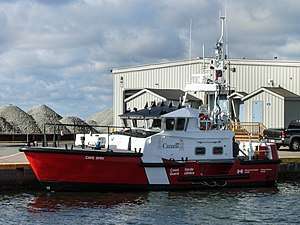CCGS Cape Spry
CCGS Cape Spry [note 1] is a Cape-class lifeboat in the Canadian Coast Guard Service, stationed at Souris, Prince Edward Island.[1]
 CCGS Cape Spry at Souris, Prince Edward Island, Canada | |
| History | |
|---|---|
| Name: | Cape Spry |
| Namesake: | Cape Spry on Eastern Prince Edward Island near the town of Souris |
| Operator: | Canadian Coast Guard |
| Builder: | Victoria Shipyard Ltd., Victoria, British Columbia |
| Completed: | 2003 |
| Homeport: | CCG Base – Souris, Prince Edward Island |
| Identification: | MMSI number: 316004846 |
| Status: | In active service |
| General characteristics [1] | |
| Class and type: | Cape-class motor lifeboat |
| Tonnage: | |
| Length: | 14.6 m (47 ft 11 in) |
| Beam: | 4.27 m (14 ft 0 in) |
| Draft: | 1.37 m (4 ft 6 in) |
| Propulsion: | 2 × diesel electric engines, 671 kW (900 hp) |
| Speed: | 22 knots (41 km/h) cruise |
| Range: | 200 nmi (370 km) |
| Complement: | 4 (2 officers and 2 crew) |
Design
Like all Cape-class motor lifeboats, Cape Spry has a displacement of 20 short tons (18 t) and a total length of 47 feet 11 inches (14.61 m) and a beam of 14 feet (4.3 m). Constructed from marine-grade aluminium, it has a draught of 4 feet 6 inches (1.37 m). The vessel is powered by two Caterpillar 3196 diesel engines driving dual propellers. Its crew complement is four with two being officers.[1]
The lifeboat has a maximum speed of 25 knots (46 km/h; 29 mph) and a cruising speed of 22 knots (41 km/h; 25 mph). Cape-class lifeboats have fuel capacities of 400 US gallons (1,500 l; 330 imp gal) and ranges of 200 nautical miles (370 km; 230 mi) when cruising.[1][2] Cape Spry is capable of operating at wind speeds of 50 knots (93 km/h; 58 mph) and wave heights of 30 feet (9.1 m). It can tow ships with displacements of up to 150 tonnes (170 short tons) and can withstand 60-knot (110 km/h; 69 mph) winds and 20-foot (6.1 m)-high breaking waves.[2]
Communication options include Bendix-King KY196 VHF AM, Ross DSC 500 VHF FM and Motorola Micom HF radios.[1] The boat has an Anschutz Gyrostar II gyro and a Furtuno 1942 X Band radar system. Other electronic systems for this lifeboat include an ICAN Aldebaran II electric charting system, JMC DF5500 VHF depth indicator, Si-Tex Koden CVS 106 depth sounder, Magnavox MX400B global positioning system and a Comnav 2001 autopilot system[1]
See also
References
Notes
- CCGS stands for Canadian Coast Guard Ship
Citations
- "CCG Fleet: Vessel Details – CCGS Cape Spry". Canadian Coast Guard, Department of Fisheries and Oceans. Archived from the original on 28 July 2018. Retrieved 28 July 2018.
- "Motor Life Boat 47-Foot MLB: International Affairs (CG-DCO-I)". United States Coast Guard, Department of Homeland Security. 1 July 2015. Retrieved 19 August 2015.
External links
| Wikimedia Commons has media related to CCGS Cape Spry (ship, 2003). |